.
CET Talks: Accreditation, Learning and Leadership
Episode 07
SEPTEMBER 5 2023 . 26 MINUTES

Episode 07: Data Analytics for Training Businesses
Randy Bowman, Interim President and CEO of IACET, and co-host, Mike Veny, CEO of Mike Veny, Inc., an IACET Accredited Provider, sit down with Julie Strecker, Dean of Accreditation and Compliance for the Art of Education University. Julie discusses how organizations can measure their effectiveness and the steps needed to develop a data collection and data management plan. Julie also shares her thoughts on the difference between measuring the effectiveness of training for learners versus measuring effectiveness for a training organization or department.
Listen to the Podcast

Welcome to CET Talks, the International Accreditors for Continuing Education and Training’s podcast, where we convene thought leaders in the continuing education and training ecosystem to share ideas, research, best practices, and experiences that promote the creation of a world that learns better. Your hosts are Randy Bowman, Interim President and CEO of IACET, and certified corporate wellness specialist Mike Veny.
Randy Bowman, Interim President and CEO of IACET, and co-host, Mike Veny, CEO of Mike Veny, Inc., an IACET Accredited Provider, sit down with Julie Strecker, Dean of Accreditation and Compliance for the Art of Education University. Julie discusses how organizations can measure their effectiveness and the steps needed to develop a data collection and data management plan. Julie also shares her thoughts on the difference between measuring the effectiveness of training for learners versus measuring effectiveness for a training organization or department.

Transcription
Host: Welcome to CET Talks, the International Accreditors for Continuing Education and Training’s podcast, where we convene thought leaders in the Continuing Education and Training ecosystem to share ideas, research best practices, and experiences that promote the creation of a world that learns better. Enjoy the episode.
Randy Bowman: Hello, and welcome to CET Talks. My name is Randy Bowman, and I’m your staff host. I’m joined today by my co-host, Mike Veny, a certified corporate wellness specialist, and CEO of an IACET-Accredited Provider. Hi, Mike. Welcome.
Mike Veny: Hi, Randy. How are you?
Randy Bowman: Rocking as always.
Mike Veny: Well, I sent an email this week—I don’t know if you got it— where I was asking Doug with Workforce 180 about analytics, about the podcast. I wanted some analytics. And you know, the reason I’m getting into this is because, in episode two we worked with Megan Torrance, and she talked a lot about data. I’m really starting to geek out on this stuff, but it’s important that we have analytics about the show, right?
Randy Bowman: Oh, sure. I mean, I know I’m having a blast, and I think you’re having a lot of fun, too, but this isn’t just about fun, is it? We want this to be effective and meaningful and changing the culture of education and training, and so we need analytics to make sure that’s happening.
Mike Veny: That’s why today is a very important episode. I’m really excited to introduce our guest, Julie Strecker. Julie has a PhD in educational leadership from Mercer University, an MA in Foreign Languages from West Virginia University, over 20 years of experience in developing and managing education programs for adult learners classroom experience as an ESL facilitator and formerly worked at the Art of Education University, serving as the Dean of Accreditation and Compliance, and as co-chair for the Institutional Effectiveness Committee. Welcome to our show, Julie.
Julie Strecker: Thanks, Mike. It’s great to be here.
Mike Veny: As we get started here, I want to ask you a question. How does institutional effectiveness improve an organization or create positive change?
Julie Strecker: That’s a great question, Mike. There are so many ways that institutional effectiveness can improve an organization and create positive change. First and foremost, it’s going to help you not only know how you’re doing, see where you’ve come from, and help you stay on track for where you want to go. But when you adopt institutional effectiveness practices and you get all members of your organization on board, then what it really does is it changes the culture of your organization, and it helps your organization create purpose. It facilitates communication among all people at all levels at your institution. It also helps you communicate better with your stakeholders, whether that’s your customers or the public at large, potential employees in the future. It helps frame your discussion and present your organization in a positive way and also a very transparent way
Randy Bowman: In your business experience, can you give us a specific example of where you’ve seen institutional effectiveness as a process, impact change to the business, and change the business processes?
Julie Strecker: Absolutely. I think one of the best examples I have to share comes from my experience working with a university and working with an intensive English program where we had a large faculty and a number of courses. We had students coming to visit us from all over the world, but we really didn’t have that institutional mindset where we were setting goals and working towards our goals and measuring our student performance. We were trying to recruit as many students as possible, get them in the door and count how many dollars we were making by bringing these students in. But through my experience with the organization, we sat down, we started doing strategic planning, we talked about our goals. Suddenly, we experienced a shift within the organization where faculty members weren’t arguing with the staff members about what they wanted to teach and how they wanted to teach it. People weren’t looking at the administration thinking, what are you spending all this money on traveling here, or traveling there, or trying to recruit students. You know, when we sat down together as a group and we talked about where we were and what we needed to do, what our goals were and how we were achieving our goals, and everyone had input into the best actions we could take to achieve our goals, then suddenly, there was more transparency in the organization. People felt more confident about what they were doing. They were more open to change because they could see where the change could make a positive impact, not only in our recruitment and our retention, but our students’ experiences all around.
Randy Bowman: That’s so awesome to hear. So how does an organization or department take those first steps to measuring its effectiveness? What would that look like, do you think?
Julie Strecker: It’s always going to depend on the organization, but I think if you’re not anywhere near institutional effectiveness, the first steps would be just sitting down and saying, “Okay, we are doing a great job. We love working here. This is a great business. We are making a positive impact in our community, but we need to do better. How do we figure out how we’re going to do better if we can’t really quantify where we are right now? Let’s sit down and talk about who we are and what our goals are and how we want to achieve those goals. Then talk about how we’re going to measure our achievement for those goals and what we can do as a team to get to the next step. I think opening that conversation is really the most important because institutional effectiveness doesn’t work if everybody is not on board. People feel like they’re being monitored, or people don’t see the value in collecting data and analyzing data because they have too many other things to do and they’re too busy. You know, the day-to-day can really bog us down. If we can’t take a step back and take a broader view of the whole picture, then we get stuck seeing the trees and not the forest. But if we talk to everybody, create consensus, and help everybody understand that we need to know the outline of the forest, and we need to know how the trees in the forest contribute to the health and the growth of the entire forest, then it’s easier to move forward into some of the more tedious parts of institutional effectiveness, like data collection and data management and analysis and things like that.
Mike Veny: Julie, I appreciate all that you’re sharing. I’m just going to voice a complaint right now to everyone here. I wish I could have heard this episode when my company was applying for IACET accreditation. A lot of the listeners that are listening to this, some of them are established training providers that are larger companies, but some are very, very small companies like my own. I remember putting my mission statement on the application and thinking, “Well, how do I measure this thing?” What would you say to someone who’s thinking about applying for accreditation, who’s not a big organization, and they want to show that their organization is effective?
Julie Strecker: I think that’s a great question, Mike. I’m glad to be a part of this now and helping out new accrediting provider applicants as they join. Your mission is you; your mission is who you are. I think it’s important to realize that we’re not trying to measure your mission. What we want to measure is your attainment of your goals. So really, as you’re starting out and you’ve got your mission statement, you say, this is who we are. The next question is, what does that mean? Who we are? Take IACET, for example. IACET’s mission is to create a world that learns better. What does that mean? Then we start asking that question, and that’s how we figure out what our goals are and how we’re going to measure them. When we say we create a world that learns better, again, what does that mean? As an organization, you have to define that. So, who’s the world? Who are the people we’re talking about? It’s our accrediting providers. Or Accredited Providers. IACET Accredited Providers have customers and clients, and so they’re encompassed in IACET’s mission to improve. Then the next question is, what does it mean to improve? We want a world that learns better. Well, first we have to know how the world is learning. What does that mean for IACET? Well, how many Accredited Providers do we have? What industries do they come from? How long have they been with us? What are their goals? We start thinking along those lines to figure out who we’re serving and what they need from us, and then we develop our goals based on that. What are our goals? If we want to grow our numbers of Accredited Providers in what direction, and in what industries? You start asking these questions and then you develop some goals. Of course, you might have a gillion goals, but you have to think long term and short term. You think, okay, what are we going to do this year? What are we going to do in the next three years, and who are we going to be five years from now? You set your goals along those lines, and then you think how are we going to attain that? What’s your mission?
Mike Veny: My company’s mission is to support people in discovering the gift of emotional wellness through unique learning experiences designed to empower your personal and professional growth.
Julie Strecker: Okay. So unique learning experiences is the first thing that I heard. I think one question you need to ask yourself as an organization is, what does that mean? What are those unique learning experiences? What is it you’re promising your customers? You want them to grow, so it’s your responsibility to measure how they’re growing. Then the question is, what’s your goal? What’s your goal for your customers? You want to improve the lives of your clients, and you do that by providing unique learning experiences. Define those unique learning experiences and then determine how many you want to do every year, how many clients you want to have; what’s effective for you? How many clients can you have and still be effective? If you want to grow, what are you going to need to do to be able to continue that level of effectiveness and still grow? All of those kinds of questions are what institutional help effectiveness helps you answer. We’re doing good now; what does that mean? How many clients do we have? How many different learning opportunities do we offer? How busy are we? Are we able to sustain this at this level? Okay, if we want to improve that, the next question is, what do you want to improve first? Are you going to look at your customer feedback and say, let’s improve my customer’s experience, let’s improve their learning? If you said, how we’re going to improve their learning? Well, how are you going to improve their learning? First, you have to be able to measure what they’re learning, and then you have to figure out how to improve that. If that’s through the assessments that you give them, if that’s through their personal feedback, you have to find those elements that are going to help you measure that learning. You have to look inward, too. Do I know enough to be able to get them to the next level? Do I need my own professional development to be able to take my clients to their next level? You need to incorporate that into your business plan so you know you are constantly learning and growing, so you can provide the learning and growing your clients need. Or maybe achieve a different level of learning with a different set of clients, always remembering what our mission is. If your mission is very specific, like you do training for people who build electric cars, then your training doesn’t necessarily need to reach people who read gas meters. But if you are training people in a corporate situation to achieve better work-life balance, and that’s a part of corporate life you are not familiar with, you need to learn a little bit more about it so you can make sure you have authority with your clients, and you’ve got the empathy for their situation that they need you to have to be able to help them. Does that make sense?
Mike Veny: That makes sense and thank you for sharing all that. Basically what I got from this, thus far, is deep spiritual work that an organization has to do. Like in all seriousness, it’s very deep spiritual work.
Randy Bowman: Yeah. I’m right there with you. You’re asking all these very introspective questions but at the same time, I know there’s some science there, there’s some technical work about, “Okay, I have these great questions. How do I know what data to collect? How do I know how to manage that data to measure these deep spiritual questions? How do I tie the reality of the world with this very mission-focused idea?”
Julie Strecker: And again, that all begins with questions. That’s the part I love about institutional effectiveness, because I’m naturally a curious person and I love to ask questions. Say, for example, you’ve got a business, and you want to grow your clientele. One question you ask is, who are they? Well, beyond that you ask, where are they? You know, maybe all of your learning is online, but you still need to know, for example, if you’re going to offer synchronous learning. What time zones work for your clients; what time periods work for your clients? If you’re going to offer asynchronous learning, maybe that’s not as important. But if you want to branch out and you want to tap into your client base to grow your client base, if all of your clients are located in the southeast United States and you want to cover the entire United States, you know, then maybe you need to find a few clients in a few other regions to help you branch out through word of mouth. So, and when you’re asking, “what data?”, that’s where you start. What data do we need to be able to answer the question? Who are my clients? How am I going to get more clients? Which parameters are most important? Is location important? Is age important? Is socioeconomic class important? Is gender important? You determine if this information is going to be important, it’s going to help me answer the question, then that’s the information that you collect. If you say, “I want to expand my client base, and I want to know what kind of cars they drive”, but your business doesn’t have anything to do with automation or automobiles, then why would you ask that question? It’s really just a matter of what am I going to be able to do with this information and is this information going to provide me with the picture that I need to be able to move forward?
Mike Veny: I’m going to go entrepreneur here on you for a moment, right here. You got me thinking, and this is probably a totally separate episode here, but I’m just going to talk about it right now. If you run a training organization more than a department, you have to focus on marketing. Sometimes your buyer is different than your customer, your end user. Yes. In my mind, there is a whole web of things that are happening that have to interrelate to one another from different areas of the business for things to be effective. Is that what you are getting at?
Julie Strecker: That’s absolutely true. If you are working with corporations and they’re the one that purchased your product, but the product is there to serve their employees, you need to make sure that the employees get what they expect and makes them happy, but you have to sell it to their employer. That might be two completely different messages.
Mike Veny: Oh, yes.
Julie Strecker: Yeah. In order to know your audience, you have to ask some questions, and then you need to look at your message and ask yourself, is this going to ring true for this audience? But in terms of data collection and what questions to ask, that’s where it’s really helpful to work with a consultant or look into some sort of training program or management program that helps you conceptualize this. Like the Malcolm Baldridge way, for example, for institutional effectiveness. That’s a proven award-winning institutional effectiveness framework. You buy a book, and you can work from that framework, and that’s going to help you when you start thinking about, what questions do I need to ask, and which things are going to be important for me? You start with something that’s kind of an overarching framework, and then you narrow it down and make choices based on your individual business’ needs.
Mike Veny: I have two more questions for you. We had Meg Torrance on here, and one of the questions I asked her; I did a little research on her and found out she was a hockey player in her spare time. So, I got to ask her how she uses data analytics and hockey, but I couldn’t find anything about you. I want to ask you; how do you use data to measure the effectiveness of your personal life?
Julie Strecker: I’m more in the continuous improvement side things there. I mean data effectiveness in my personal life, it’s more things like, how many steps did I take today, because wellness is important for me. How many zone minutes did I get? Did I get my heart rate up? How many calories did I take in today? How much time did I spend working on this project or that project? How much quality time did I spend with my family members? How many things did I check off my to-do list for this job? For me, that’s the data I look at in my daily life. Did I get up at the same time every day, or did I put my shoes on before I started working because I worked from home today. Sometimes, you know, that’s a positive for me. I have my own data points and I go through those and when things start to get difficult, that’s what I look at; did I do these things? Did I continue this? Did I eat unhealthy this week? Did I lose sleep this week? That’s affecting my ability to perform at the level that I prefer to be at personally.
Mike Veny: Thank you for sharing that. What does a world that learns better look like to you?
Julie Strecker: It’s introspective, as you’ve mentioned to me. A world that learns better is a mindful world, a world that takes into consideration its context and the things around it. It’s a world with growth mindset. I mean, we can all be great, but there’s always room for improvement. I think the key to the whole idea of institutional effectiveness is realizing there’s always room for improvement and always striving toward being just a little bit better. It’s not even that you have to go from being a novice to being a professional in one year. It’s just incremental baby steps, always working to improve. For me, a world that learns better is a world that can reflect on where it’s come from and have its eye on where it’s going and can be flexible and modify its goals based on what’s happening around it.
Mike Veny: Awesome. Thank you for such a wonderful interview. There’s so many nuggets here. You know, Randy, I want to tell you my quick takeaway is that I need to start asking the deeper questions about different aspects of our company and really going deep as to why and what that looks like. Asking questions like, “What will that look like?” That will help me a lot. What about you?
Randy Bowman: I’ve really enjoyed you today, Julie, and I think even though you never said the word, the word that kept going through my mind as you were talking over and over again is the word ‘intentionality’. So much of being effective is being intentional. You’re asking questions to drive you towards taking planned, precise, intentional steps, not just succeeding because it happens to fall into your lap. That was my takeaway.
Mike Veny: As we head out today, I want to ask you, our listeners, how do you measure the effectiveness of your training organization or department? We’d love to have you find us on LinkedIn or Twitter at IACET.org and share your experiences.
Randy Bowman: If you’re interested in being a more effective organization and are not already accredited, let me say, this is a great opportunity for you to start your journey. By its very nature, accreditation propels an organization to measure effectiveness, and it’s a great tool to use for ongoing improvement. It’s not just a one-time event, as Mike reminds us over and over again. Accreditation is not something that successful organizations do once and forget about. It’s a strategic process that is integrated into the organization’s ongoing operations. Don’t forget that. Take the time today to become accredited. For all of our listeners, please don’t forget, you can submit topic ideas, suggestions for guests, and other feedback on the CET Talks podcast page, on the IACET.org website. We certainly hope you were encouraged today. We hope you’ll subscribe to this podcast on your favorite podcast platform, so you don’t miss any episodes. Thank you so much for joining us today.
Host: You’ve been listening to CET talks, the official podcast of IACET. Don’t forget to subscribe to the podcast on Spotify, Apple Podcast, or wherever you listen to podcasts. To learn more about IACET, visit IACET.org, that’s I-A-C-E-T.org. Thanks for listening, and we’ll be back soon with the new episode.

Episode 31: Training Tomorrow’s Talent: Exploring Certification, Standards, and Impact with ATD’s Certification Institute

Episode 30: Silos to Synergy: Holistic Approaches to Creating Collaborative Learning

Episode 29: Credentials in Crisis: Challenges and Opportunities in Modern Education Recognition

Episode 28: Accreditation Uncovered: Essential Insights from an Industry Leader

Episode 27: Two Truths with a Lie: Managing the Myths of Modern-Day Learning

Episode 26: From Bending to Blending: Best Practices in Integrating Externally-Created Content

Episode 25: From Insight to Action: Charting the Career Path of a SME-turned-ISD

Episode 24: Cultivating Careers: The Power of Employee Engagement for Organizational Success

Episode 23: Igniting Imagination: Crafting Creativity in Training Environments

Episode 22: The Metrics of Change: Navigating Purposeful Measurement in L&D

Episode 21: Pathways to Success: The Value of Lifelong Learning through Digital Credentials

Episode 20: Outcomes to Achievement: Crafting Tomorrow’s Workforce Through Competency Models

Episode 19: Chatting with the Future: Enhancing AI Output Through Prompt Engineering

Episode 18: On the Inclusive Frontier: Harnessing Neurodivergence in Modern Training

Episode 17: Designing with Purpose: Strategies for Accessible e-Learning Development

Episode 16: Innovating Education: Navigating Accreditation for Short-Term Training

Episode 15: Beyond the Basics: Elevating Virtual Training through Expert Facilitation


